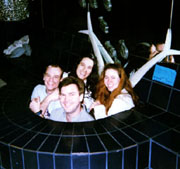Lab
Stephen L. Johnson Lab
|

|
Statement of Research Interest
My lab is interested in growth control and morphogenesis in zebrafish development. Thus, we study the pigment pattern and the control of size and regeneration of the fin. Our basic approach is to identify mutations that affect adult pigment stripe pattern or fin growth and regeneration and analyze the mutations in singly or multiply mutant fish to identify the tissues and genetic pathways affected. Additionally, we are trying to identify the genes affected by the mutations, and are working to develop genetic and physical maps that will lead to isolation of these genes.
Melanocyte stem cells: Between 2 and 4 weeks of development the embryonic pigment pattern is replaced by the adult pigment pattern. Analysis of mutations indicates that the melanocytes of the adult pigment pattern develop from multiple populations of undifferentiated precursors or stem cells that are presumably derived from the embryonic neural crest. Adult melanocyte stem cells are activated to develop at distinct stages of development, as the animal grows, or in regenerating fins following amputation. We are now working to identify the different populations of stem cell in the adult tissue.
Proportionate growth: Zebrafish grow throughout their lives, slowing the rate of growth after reaching maturity. The rates of growth of the fins and the body are regulated to achieve constant proportion of fin length to body length at all stages. From phenotypes of mutations that affect fin size, we infer that the long fin mutation relieves the coupling between fin growth and body growth, and the short fin mutation retains coupled growth, but changes the proportionality constant. Identifying the affected genes by positional cloning or candidate gene approaches will shed light on the mechanisms that impose proportionate growth on the different tissues and organs of vertebrate animals.
Regeneration: Zebrafish fins regenerate rapidly following amputation. Fin regeneration is similar to amphibian limb regeneration; following amputation, differentiated bone cells apparently dedifferentiate and enter the cell cycle, rapidly divide and migrate from the stump to form a regeneration blastema. Formation of the blastema is followed by a period of rapid growth, with continued proliferation of some blastema cells matched by withdrawal of other cells from both the blastema and the cell cycle to form new bone. Analysis of mutations should help to understand the molecular basis of these growth control mechanisms.
Melanocyte stem cells: Between 2 and 4 weeks of development the embryonic pigment pattern is replaced by the adult pigment pattern. Analysis of mutations indicates that the melanocytes of the adult pigment pattern develop from multiple populations of undifferentiated precursors or stem cells that are presumably derived from the embryonic neural crest. Adult melanocyte stem cells are activated to develop at distinct stages of development, as the animal grows, or in regenerating fins following amputation. We are now working to identify the different populations of stem cell in the adult tissue.
Proportionate growth: Zebrafish grow throughout their lives, slowing the rate of growth after reaching maturity. The rates of growth of the fins and the body are regulated to achieve constant proportion of fin length to body length at all stages. From phenotypes of mutations that affect fin size, we infer that the long fin mutation relieves the coupling between fin growth and body growth, and the short fin mutation retains coupled growth, but changes the proportionality constant. Identifying the affected genes by positional cloning or candidate gene approaches will shed light on the mechanisms that impose proportionate growth on the different tissues and organs of vertebrate animals.
Regeneration: Zebrafish fins regenerate rapidly following amputation. Fin regeneration is similar to amphibian limb regeneration; following amputation, differentiated bone cells apparently dedifferentiate and enter the cell cycle, rapidly divide and migrate from the stump to form a regeneration blastema. Formation of the blastema is followed by a period of rapid growth, with continued proliferation of some blastema cells matched by withdrawal of other cells from both the blastema and the cell cycle to form new bone. Analysis of mutations should help to understand the molecular basis of these growth control mechanisms.
Lab Members
| Hultman, Keith Graduate Student | O'Reilly-Pol, Thomas Graduate Student | Hindes, Anna Research Staff |
| McAdow, Ryan Research Staff | Higdon, Scott Fish Facility Staff |
